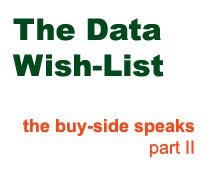 This is the second of a two-part series as we asked buy-siders: “If there was one thing you could change about the use of data in digital ad targeting tomorrow, what would it be?”
This is the second of a two-part series as we asked buy-siders: “If there was one thing you could change about the use of data in digital ad targeting tomorrow, what would it be?”
Click on a participant’s name or scroll down to view responses:
- Adam Cahill, EVP, Media Director, Hill-Holliday
- Kurt Unkel, SVP, VivaKi Nerve Center
- Sara Livingston, Manager, Display Advertising, The Ladders
- Eugene Becker, Director, Analytics, Media Innovation Group (The MIG)
Adam Cahill, EVP, Media Director, Hill-Holliday
“I get the sense that premium publishers aren’t benefiting from the current approach to data, and I’d love to see that change.
As buyers we can access intent data and then apply it to any inventory, but in that scenario premium pubs are selling their space at a steep discount, and not benefitting financially to the extent they should. The audience piece of the equation is trumping the placement piece.
I’m for anything that encourages premium pubs to free up more inventory, and the best way to do that is to ensure they’re winning financially. So what if the OPA instituted a data sharing platform across its member properties, creating a new body of behavioral data to buy against.
Then that data could be applied to buys on any of their member properties, and the compensation structure would be a 50/50 split between the publisher that contributed the data originally and the publisher that ultimately served the impression.
Something like that would both create a new, valuable source of data, and might also bring better inventory into the exchange space.”
Kurt Unkel, SVP, VivaKi Nerve Center
“Expectations. There is a time and a place for data usage, but every situation doesn’t benefit from layering data (and costs) onto existing media. There’s a great eagerness to test all types of data on all types of objectives, but without proper metrics and benchmarks, the potential value created can be missed. For performance clients, gauging the incremental lift in value is critical. So if you can’t quantify one lead’s value from the next, you likely will find greater success & scale just driving raw conversions without data. If you are brand-oriented, and focused on TRP-esque metrics, you need to know what your other channel’s effective CPM against that target is. Without such benchmarks, proving the data costs have created incremental value will be a challenge.”
Sara Livingston, Manager, Display Advertising, The Ladders
“Hands down one of the biggest growth opportunities regarding the use of data in display targeting is in narrowing the gap between the data and display inventory supply sources. In an ideal ecosystem data sources would be media agnostic and could be applied to any media buy, be it site-direct or RTB/non-RTB inventory purchased via a DSP/ATD. This would enable advertisers to easily transfer data segments across buys and greatly increase the scaleability of hyper-targeted/data-overlaid media in general.
Of course this primarily applies to 3rd party data sources and data tech companies (as there are a multitude of backend solutions for applying 1st party data segments across all media placements). Advertisers are limited to the 3rd party data solutions their publisher partners and DSP/ATD currently offer, and unless they are buying significant amounts of data, using a DMP as a workaround is cost-prohibitive.
Both 3rd party data sources and DSPs have done an incredible job to date of making more data sources available across buying platforms. Additionally as more publishers develop either private exchanges or RTB-enable their inventory, this issue will be alleviated on that front as well. However the sooner all parties can arrive at this point the better. There’s no doubt it will open the door for not only additional funds to be spent on 3rd party data but on display and digital media in general.”
Eugene Becker, Director, Analytics, WPP Group’s Media Innovation Group (The MIG)
“There are two issues that complicate the world of data used for ad targeting. First, the number of options can be overwhelming. There are literally tens of thousands of audience segments available across dozens of data vendors. This is a dream come true for a data maven, but for most media planners this is very confusing. The second issue that greatly complicates the data landscape is price. The data is expensive relative to non-premium media inventory. The end result is that media planners can hurt campaign performance by buying based on audience data.”
From yesterday, view Part I’s responses:
- Andrew Leinicke, Media Director, RBM
- Donald Williams, Chief Digital Officer, Horizon Media
- Marcus Pratt, Associate Director, Insights and Technology, Mediasmith
- Neeraj Kochhar, President, Varick Media Management













